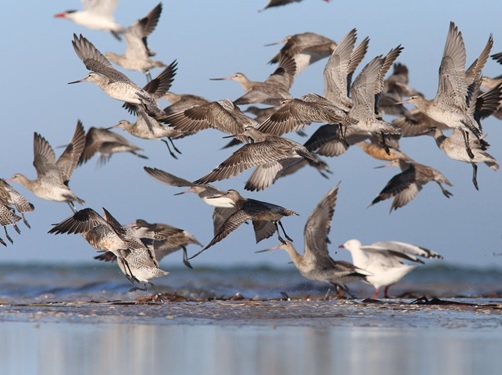Empowering communities to take action for shorebird sites in local areas
Migratory Shorebird Site Action Plans (SAPs) are a concept developed by BirdLife Australia with the aim of empowering communities and stakeholders to take targeted action for specific shorebird sites in a local area. Plans are developed by communities and owned locally with facilitation/expert guidance from BirdLife. In a structured approach, threats to migratory shorebirds in the area are identified and concrete actions for improved conservation outcomes defined. Local stakeholders and communities then seek the necessary resources and implement their actions. SAPs thus identify low-hanging fruit, with the ability to fast-track high impact conservation ideas and complement existing conservation planning schemes. The coastline and islands around Western Port and Phillip Island are significant migratory shorebird habitat, both nationally and internationally, and key to maintaining healthy migratory shorebird populations in Victoria.
Ongoing population declines driven by threatening processes have already led to eight species of migratory shorebirds being listed as threatened at national level, with some species such as Far Eastern Curlew experiencing declines of more than 85% in a few decades. It is critical that threatening processes are identified and tackled at local level. Since 2019, BirdLife Australia has led the development and delivery of 20 SAPs around Australia and has worked collaboratively with local land managers to implement those plans in three Australian states. The idea has proven highly successful in engaging communities, often key to overcoming anthropogenic threats to shorebirds. Currently, with seeding money support from Western Port Biosphere, BirdLife is conducting a feasibility study for a SAP for Western Port and sees enormous potential for a full Site Action Plan process to be started.
The project proposed aims to identify and manage threats to migratory shorebirds in Western Port at community level, a sustainable long-term approach critical to ensuring survival of a whole range of threatened species at a key site of international importance. It will also raise community awareness and promote education through targeted resources, events and ongoing community engagement.

Themes and Local Areas
| Primary Theme: | Native animals |
| Other Themes: | Land Use, Coasts, Communities |
| Primary Local Area: | Western Port |
| Other Local Areas: | Bass Coast, South Gippsland & islands |
| Project location: | In Western Port and at Phillip Island |
| Scale of the project: | Local |
| New or continuing work: | Continuing/building on previous work |
Project partners
| Lead organisation: | Birdlife Australia |
| Key partners: | Department of Energy, Environment and Climate Action (DEECA), Phillip Island Nature Parks, Western Port Biosphere, Steering Committee of Australia’s National Migratory Shorebird Conservation Action Plan |
| Registered Aboriginal Party/s relevant to the project or its area: | Bunurong Land Council Aboriginal Corporation |
Investment opportunities
| Opportunities for investors within this project start from: | $$ (Tens of thousands of dollars) |
| Estimated scale of investment for full project implementation: | $$$ (Hundreds of thousands of dollars) |
| Estimated timeframe for full project implementation: | 2-10 years |
Contribution toward targets
| Primary Regional Catchment Strategy targets: | Native Animals – Wild populations of all threatened native animal species in the region are retained and their populations are self-sustainable, secure, healthy and resilient Community – Community volunteering for natural resource management surpasses 1 million hours per year. Community – Over two million people participate annually in natural resource management events and activities conducted by relevant agencies, councils and community groups across the Region. Ramsar wetlands – The ecological condition of the Western Port Ramsar wetland is maintained or improved from 2021 to 2050 |
| Relevant Biodiversity 2037 goal: | Protect or assist one or more critically endangered or endangered species/community of native vegetation or native animal |
| Relevant National Landcare Program priority: | Ramsar – Western Port Ramsar site – Ecological character maintained or improved |
More information
https://birdlife.org.au/shorebirds (Program Overview); https://birdlife.org.au/projects/shorebirds/saps (Site Action Plans for Migratory Shorebirds); https://birdlife.org.au/projects/shorebirds/mscap (Australia’s National Conservation Action Plan); Email: shorebirds@birdlife.org.au


